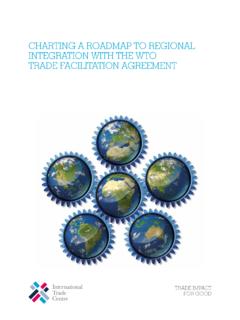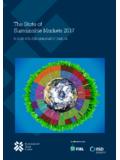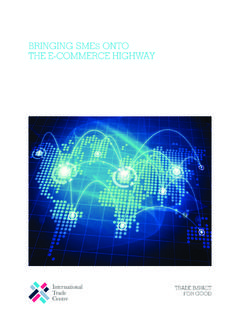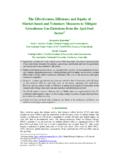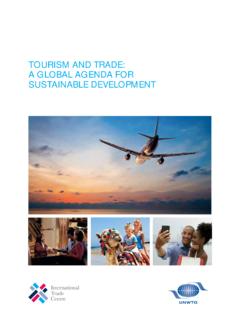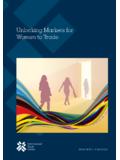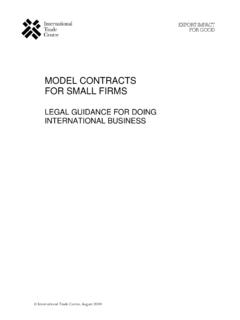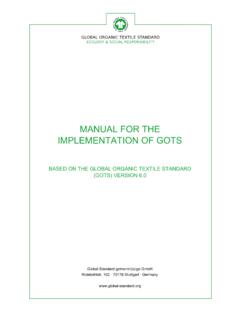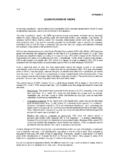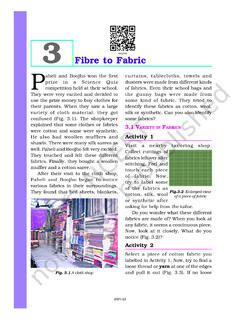Transcription of THE CHINESE MARKET FOR CLOTHING
1 THE CHINESE MARKET . FOR CLOTHING . THE CHINESE MARKET FOR CLOTHING . Abstract for trade information services ID=42692 2011 SITC-84 CHI. International Trade Centre (ITC). The CHINESE MARKET for CLOTHING . Geneva: ITC, 2012. xi, 92 p. (Technical Paper). Doc. No. Survey on CHINESE MARKET for CLOTHING - describes the structure and characteristics of the domestic CHINESE MARKET for CLOTHING ; provides an analysis of the tariff structure of imports by product group;. outlines special import regulations, customs procedures, transport, as well as requirements relevant to packaging, labelling, standards, and ethical trading; examines the MARKET potential, the consumer preferences and behaviour; provides an overview of the distribution channels, the major brands, the procurement practices including the use of e-commerce and ICT procurement; highlights the key players in China's textiles and garment MARKET , the possibilities for cooperation along the value chain, and the existing national support schemes.
2 Appendices include contacts details of sector related companies in China. Descriptors: CLOTHING , Standards, Packaging, Distribution, Procurement, Electronic Commerce, Consumer Behaviour, MARKET Surveys, China. For further information on this technical paper, contact Mr Matthias Knappe, English The International Trade Centre (ITC) is the joint agency of the World Trade Organization and the United Nations. ITC, Palais des Nations, 1211 Geneva 10, Switzerland ( ). Views expressed in this paper are those of consultants and do not necessarily coincide with those of ITC, UN or WTO.
3 The designations employed and the presentation of material in this paper do not imply the expression of any opinion whatsoever on the part of the International Trade Centre concerning the legal status of any country, territory, city or area or of its authorities, or concerning the delimitation of its frontiers or boundaries. Mention of firms, products and product brands does not imply the endorsement of ITC. This technical paper has not been formally edited by the International Trade Centre. Digital image on the cover: ITC. International Trade Centre 2011. ITC encourages the reprinting and translation of its publications to achieve wider dissemination.
4 Short extracts of this technical paper may be freely reproduced, with due acknowledgement of the source. Permission should be requested for more extensive reproduction or translation. A copy of the reprinted or translated material should be sent to ITC. ii THE CHINESE MARKET FOR CLOTHING . Acknowledgements The International Trade Centre (ITC) thanks the following for their contribution to this technical paper: Qingliang Gu, Author, Consultant ITC Staff: Matthias Knappe, Senior Officer and Programme Manager, cotton , Textiles and CLOTHING Natalie Domeisen-Schibilia, Senior Public Information Officer Isabel Droste, Publications Assistant Kathryn Della Corte, Senior Secretary Kedsenee Premprung, Project Assistant Vicky Hagen, Document Formatter iii THE CHINESE MARKET FOR CLOTHING .
5 Iv THE CHINESE MARKET FOR CLOTHING . Contents Acknowledgements iii Abbreviations xi 1. Executive summary 1. Background 1. The scale and characteristics of China's CLOTHING MARKET 1. Key players in China's CLOTHING MARKET 2. MARKET entry strategies of developing countries and LDCs 2. 2. The structure and characteristics of the domestic MARKET : a macro view 3. MARKET size 3. Population and GDP growth 3. Growth of income and CLOTHING consumption 3. Retail sales in the domestic MARKET 5. MARKET characteristics: dualism in consumption patterns 7. Supply by domestic and overseas industry 9.
6 Menswear 10. Womenswear 10. Children's wear 10. Casual wear 10. Sportswear 11. Lingerie and underwear 11. National apparel clusters 11. Import developments over the last five years 12. Growth of imports 12. Imports from LDCs 12. 3. An analysis of the tariff structure of imports by product group 14. Tariff system 14. Tariff structure for textiles and CLOTHING 14. Tariff systems for textiles and CLOTHING from LDCs 15. Conventional tariff rate 16. Special preferential tariff rate 18. v THE CHINESE MARKET FOR CLOTHING . 4. Non-tariff requirements in the MARKET 19. Special import regulations 19.
7 Import license 19. Import quotas 19. Tariff rate quotas (TRQs) 20. Customs procedures 20. Customs procedures 20. Customs valuation 21. Pre-shipment inspection requirements 21. Freight forward and transport requirements 21. Packaging, marketing and labelling requirements 22. Standards and other technical requirements 22. National general safety technical code for textile products (GB 18401) 23. National standard of China, cotton upland cotton (GB 1103) 24. National standard of the , environmental protection control standard for imported solid waste as raw materials waste and scrap of fibres 24.
8 Announcement No. 177 of 2005 made by the Administration of Quality Supervision, Inspection and Quarantine (AQSIQ) 24. AQSIQ Notice on implementing the administrative measures on registration of overseas supplying enterprises exporting cotton to China 24. National Standard of China, seed of economic crops Part 1: fibre species 26. National standard of China, instructions for use of products of consumer interest part 4: textiles and apparel 26. National standard of China, conventional moisture regains of textiles 26. National standard of China, directions for use and labels for carpets 27.
9 Specific ethical trading requirements 27. 5. Expected MARKET development ( MARKET prospects) 27. MARKET potential 27. Diversity of consumer group 27. The growing purchasing power 28. The process of urbanization 28. Consumer behaviour 29. The change of lifestyle 29. Diversification of demand 34. Channels and distribution 34. 6. The domestic garment MARKET : a micro view 35. The players in the MARKET 35. Garment retailers 35. Major brands 37. vi THE CHINESE MARKET FOR CLOTHING . Apparel procurement practices 39. Global sourcing for the CHINESE MARKET 39. Vendor selection 39. Procurement procedure 41.
10 Use of e-commerce and ICT procurement 42. Information platform and database 42. ERP and MRP 47. Consumer preferences 50. Growing needs for natural fabrics 50. Country origin preference and price consciousness 51. Quality and comfort 52. Consumers' apparel preferences in three cities 53. 7. Cases: The key players in China's textiles and garment MARKET 56. Shenzhou Knitting Co., Ltd 56. Challenge Knitting Co. - Industry upgrading 58. IKEA 59. Zara in China 61. Shanghai Metersbonwe Fashion and Accessories Co., Ltd 63. 8. Possibilities for cooperation along the value chain 66. The textile complex and the roles of LDCs 66.

